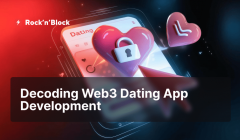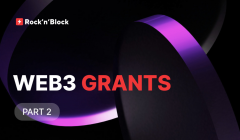How to Build Web3 Applications
03 May 2024Welcome to the era of Web3, where the internet is becoming a decentralized and trustless ecosystem powered by blockchain technology. Building Web3 applications is a pivotal endeavor in this dynamic landscape, offering unprecedented opportunities for innovation, collaboration, and empowerment. This article explores the basics of Web3 application development, providing guidance on the key steps and considerations involved in leveraging this innovative technology. We offer insights and practical tips to help you navigate the complexities of building Web3 applications and unlock their full potential in shaping the future of the internet.

Table of Contents:
-
Understanding Web3
-
Types of Web3 Applications
-
The Web3 Development Technology Stack
-
Web3 Application Development Roadmap
-
What is a Web3 Development Company?
-
Conclusion
Understanding Web3
At its core, Web3 represents the next iteration of the internet – a decentralized, trustless ecosystem built on the foundation of blockchain technology. Web3 prioritizes principles of decentralization, transparency, and user sovereignty, unlike its predecessors. This eliminates the need for intermediaries and opens up a new era of empowerment, fostering a digital landscape where users have increased control over their data and interactions.
The Evolution from Web2 to Web3
To understand the impact of Web3, it's valuable to contrast it with its predecessor, Web2, which is shaped by centralized platforms and data silos and relies heavily on intermediaries to facilitate transactions and interactions. Although it undoubtedly enables greater connectivity and innovation than ever before, it also raises issues such as data breaches, privacy concerns, and centralized control.
Web3 represents a departure from the centralized model by embracing decentralization as its cornerstone. It leverages blockchain technology and smart contracts to empower users to interact directly with each other, eliminating the need for intermediaries and fostering a more transparent and equitable digital environment.
The Promise of Web3 Application Development
If you have decided to dive into Web3 application development, there are a few things you need to know before you start coding. Web3 development requires a fresh mindset and approach, so forget everything you know about traditional application development. Unlike traditional applications, Web3 development requires a deep understanding of blockchain technology, smart contracts, and decentralized protocols.
The potential for Web3 application development is boundless. Whether you want to revolutionize finance or redefine social interactions and content creation, Web3 gives you the power to reshape every aspect of our digital existence.
Types of Web3 Applications
Let's take a deep dive into the blockchain app development landscape and explore how these Web3 apps are shaking up industries and empowering users around the globe.
Decentralized Finance (DeFi) Platforms
DeFi platform development is at the leading edge of Web3 applications and is at the forefront of the democratization of finance as we know it. They offer decentralized alternatives to conventional financial services, such as lending, borrowing, and trading, by facilitating peer-to-peer transactions and cutting out middlemen. This grants users unprecedented control over their assets and financial dealings. DeFi makes it possible to borrow money or trade assets without relying on banks or brokerage firms. It is a financial system run by the people, for the people.
Decentralized Social Networks
In the realm of social media, Web3 social media application development is giving rise to decentralized social networks that prioritize privacy, transparency, and user ownership of data. Unlike traditional social media platforms that harvest user data for profit, decentralized social networks leverage blockchain technology to empower users with control over their personal information and content. These platforms enable users to interact with each other directly, without the need for centralized intermediaries.
Find out how Web3 is transforming dating interactions: Decoding Web3 Dating App Development!
NFT Marketplaces
Thanks to Web3 application development, we now have NFT marketplaces — online hubs where users can buy, sell, and explore digital collectibles, artwork, and other one-of-a-kind assets. NFT marketplace development harnesses the power of blockchain to secure the authenticity and scarcity of NFTs, opening up exciting new avenues for creators and collectors alike.
Decentralized Autonomous Organizations (DAOs)
Decentralized Autonomous Organizations (DAOs) are a new way of governing and collaborating, made possible by Web3 application development. They are autonomous entities, who collectively make decisions and manage resources. DAOs use blockchain technology to enable transparent, decentralized decision-making and allocation of funds, fostering community-driven initiatives and projects.
Web3 Gaming Platforms
Web3 application development is also changing the gaming industry, with the emergence of blockchain-based gaming platforms. These platforms use blockchain technology to provide players with true ownership of in-game assets, interoperability between games, and novel gameplay mechanics such as play-to-earn incentives. By leveraging decentralized networks, Web3 gaming platforms offer players greater control over their gaming experiences and economic opportunities within virtual worlds.
Check out top Web3 Game Development Trends in 2024!
The Web3 Development Technology Stack
The technology stack serves as the cornerstone upon which decentralized ecosystems are built. From blockchain protocols to smart contract languages and decentralized storage solutions, the Web3 application development technology stack encompasses a diverse array of tools and frameworks that empower developers to create groundbreaking apps. Let's explore the components of the Web3 development technology stack and their impact on the future of decentralized innovation.
Blockchain Protocols
At the heart of the Web3 development technology stack lies the choice of blockchain protocols, decentralized ledgers that record and validate transactions across a distributed network. These protocols, such as Ethereum, Polkadot, and Cardano, provide the infrastructure for DApps development by offering secure and immutable data storage, consensus mechanisms, and smart contract functionality. Developers leverage blockchain protocols to create DApps that enable peer-to-peer transactions, decentralized governance, and transparent interactions.
Smart Contract Languages
Smart contracts are a core component of Web3 application development, as they are self-executing contracts with the specific terms written directly into the code. Smart contract languages like Solidity, Vyper, and Rust allow developers to define the logic and rules that govern interactions within decentralized applications. Writing smart contracts enables developers to automate processes, facilitate trustless transactions, and enforce agreements without intermediaries. Smart contract languages are crucial in the Web3 development technology stack, enabling developers to create decentralized applications that are both secure and efficient.
Decentralized Storage Solutions
In the Web3 ecosystem, decentralized storage solutions replace traditional centralized ones, prioritizing privacy, security, and censorship resistance. IPFS (InterPlanetary File System), Swarm, and Filecoin are examples of decentralized storage solutions that allow developers to store and retrieve data in a peer-to-peer manner, without relying on centralized servers or authorities. Developers can ensure data integrity, eliminate the risk of failure, and enable truly decentralized applications that are resilient to censorship and manipulation by using decentralized storage solutions.
Identity and Authentication Protocols
Identity and authentication protocols are necessary for Web3 application development because they allow users to securely authenticate their identities and access distributed services. Decentralized Identity (DID), OAuth, and OpenID Connect are some of the protocols that provide standards and frameworks for decentralized identity management, authentication, and authorization. Developers can enable users to maintain control over their personal data, protect their privacy, and securely interact with decentralized services across the Web3 ecosystem by integrating identity and authentication protocols into their applications.
Oracles and External Data Sources
Oracles serve as bridges between blockchain networks and external data sources, providing decentralized applications with access to real-world data and events. Chainlink, Band Protocol, and Witnet are examples of oracles that enable developers to securely and reliably retrieve external data, execute smart contracts, and integrate off-chain information into their decentralized applications. Developers can create Web3 applications that interact with and respond to real-world events by leveraging oracles and external data sources, unlocking new use cases and functionalities in the Web3 ecosystem.
Web3 Application Development Roadmap
To navigate the complexities of decentralized innovation effectively, it's essential to follow a structured roadmap that guides each step of the development process. Here, we present a comprehensive step-by-step roadmap for Web3 application development, empowering developers to chart their course towards decentralized success.
Step 1: Define Your Vision and Objectives
The first step in any Web3 application development journey is to define your vision and objectives clearly. Ask yourself: What problem are you solving? Who are your target users? What unique value proposition does your application offer? By articulating your goals and objectives upfront, you lay the foundation for a focused and purpose-driven development process.
Step 2: Conduct Market Research and Analysis
Once you've defined your vision, conduct thorough market research and analysis to gain insights into existing solutions, user needs, and market trends. Explore the competitive landscape, identify potential competitors and collaborators, and assess the demand for your proposed solution. By gathering actionable intelligence, you can refine your strategy and position your Web3 application for success in the marketplace.
Step 3: Choose the Right Blockchain Platform
Selecting the right blockchain platform is a critical decision that will shape the architecture and functionality of your Web3 application. Consider factors such as scalability, security, interoperability, and community support when evaluating different blockchain platforms. Whether you choose Ethereum, Polkadot, or another blockchain platform, ensure that it aligns with your technical requirements and long-term objectives.
Gain more insights in our article How to Choose Blockchain for dApp Development!
Step 4: Design Your Application Architecture
With your blockchain platform selected, it's time to design the architecture of your Web3 application. Determine the structure of your smart contracts, define the database schema, and outline the interaction flows between different components of your application. Pay special attention to security considerations, such as access control, data encryption, and protection against common vulnerabilities.
Step 5: Build the User Interface (UI) and Frontend Components
Now shift your focus to building the user interface (UI) and frontend components of your Web3 application. Design intuitive and user-friendly interfaces that enable seamless interaction with decentralized features such as wallet integration, transaction management, and decentralized governance. Leverage modern frontend frameworks such as React, Vue.js, or Angular to create dynamic and responsive UI experiences.
Step 6: Develop Smart Contracts and Backend Infrastructure
Begin the smart contracts development and backend infrastructure for your Web3 application. Use smart contract languages like Solidity or Vyper to securely implement the business logic of your application. The development of backend infrastructure entails architecting robust systems for data management, user authentication, and seamless integration with blockchain networks. This involves implementing APIs, databases, and middleware layers to ensure efficient communication between the frontend and blockchain, guaranteeing the reliability and scalability of the application. Attention is given to optimizing gas costs, enhancing transaction throughput, and implementing security measures such as role-based access control and encryption protocols.
Step 7: Test, Iterate, and Optimize
After building your Web3 application, conduct rigorous security audits and testing to identify and resolve any bugs, vulnerabilities, or performance issues. Utilize automated testing frameworks, unit tests, and integration tests to validate the functionality and security of your application.
Step 8: Deploy and Launch Your Web3 Application
With testing complete and optimizations implemented, it's time to deploy and launch your Web3 application on the network. Choose a suitable deployment strategy. configure deployment parameters, deploy your smart contracts and frontend assets, and ensure that your application is accessible to users worldwide.
Step 9: Monitor, Maintain, and Evolve
After the launch of your Web3 application, the journey is far from over. Continuously monitor the performance, security, and user engagement metrics of your application, leveraging analytics tools and monitoring solutions. Additionally, maintaining regular communication with your user community and addressing any issues or feedback promptly can help improve your application based on user insights and market trends. Foster community participation and collaboration to embrace decentralization and evolve your Web3 application in response to changing user needs and technological advancements.
To succeed in the Web3 frontier, it is important to plan meticulously, execute precisely, and refine persistently. It is advisable to seek the assistance of an expert Web3 development company due to the complexities involved. By following a well-defined roadmap for Web3 application development, developers can confidently navigate the intricacies of decentralized innovation. Crafting Web3 applications that empower users and catalyze positive transformations in the digital realm requires establishing a clear vision, selecting appropriate tools and technologies, fostering collaboration with stakeholders, and embracing iterative improvements. By maintaining a steadfast commitment to decentralization, you can chart a course toward a future where Web3 applications thrive and flourish.
What is a Web3 Development Company?
Although decentralization promises transparency, security, and autonomy, achieving these goals can be challenging. A Web3 development company can provide expert guidance and resources to help overcome any challenges.
Navigating the Complexities of Web3 Development
Trying to develop a Web3 application on your own can be like venturing into unfamiliar waters without a compass. Blockchain technology, smart contract development, and decentralized infrastructure can pose significant challenges for even the most seasoned developers. However, with the guidance of a Web3 development company, these complexities can be transformed into opportunities for innovation and growth.
Explore the advantages and disadvantages of leveraging blockchain development services and in-house development, helping you make an informed decision: Blockchain Development Services Vs In-house Development!
Leveraging Specialized Expertise
One of the primary advantages of partnering with a Web3 development company lies in their specialized expertise in blockchain technology and decentralized architectures. These companies boast teams of experienced blockchain engineers, smart contract developers, and decentralized application architects who possess deep domain knowledge and technical proficiency. By tapping into this wealth of expertise, clients can expedite the development process and mitigate the risk of costly errors and setbacks.
Accelerating Time-to-Market
In the quickly changing world of Web3 application development, time is of the essence. Delays in the development cycle can result in missed opportunities and lost competitive advantage. Hiring a Web3 development company can help clients expedite the time-to-market for their decentralized solutions. These companies use agile development methodologies and streamlined processes to deliver high-quality, scalable, and feature-rich applications promptly.
Mitigating Costs and Resource Constraints
Building and maintaining a robust Web3 application development infrastructure in-house can be a daunting and resource-intensive task. From recruiting and training specialized talent to investing in infrastructure and tools, the costs can quickly escalate. By outsourcing DApp development to a Web3 development company, clients can mitigate these costs and resource constraints. These companies allow clients to access top-tier talent and cutting-edge technology without the overhead of maintaining an in-house team.
Ensuring Security and Compliance
In Web3 application development, security and compliance are crucial. With the increasing number of cyber threats and regulations, it is essential to maintain the integrity and security of decentralized solutions. Web3 development companies implement strong security practices and compliance frameworks to protect client assets and comply with industry regulations. By entrusting development to a reputable company, clients can be confident that their decentralized applications are built with security and compliance in mind.
Embracing Collaboration and Innovation
A Web3 development company is crucial in the process of decentralized innovation. They help clients navigate the complexities of blockchain technology, accelerate time-to-market, and mitigate costs to realize their vision of decentralized solutions. Clients can confidently embark on their Web3 application development journey by embracing collaboration, innovation, and the expertise of seasoned professionals with a trusted partner by their side.
Check out our related guides on hiring a DApp development company:
The Role of a Blockchain DApp Development Company
How to Choose Your dApp Development Company
Top 5 Mistakes When Choosing a DApp Development Company
What to Ask When Hiring a Blockchain App Development Company
Conclusion
The world of Web3 applications presents numerous opportunities for innovation and creativity, with the potential to significantly transform the digital landscape. However, navigating this exciting frontier can be challenging, especially for those exploring it alone. This is where the expertise of a seasoned development company like Rock'n'Block can be invaluable. With our extensive experience in
Web3 applications development, we can guide you through every step of the process, from conceptualization to deployment and beyond. Partnering with Rock'n'Block allows you to fully benefit from the potential of Web3 technology and bring your vision to life with confidence. We are committed to being your trusted ally on this exciting journey into the future of decentralized innovation!
We ❤️ Development
Follow us on social media to receive the hottest blockchain development updates
Twitter ⚡️Telegram⚡️LinkedIn⚡️Facebook










